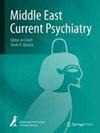Obsessions and suicidality in youth suffering from bipolar I disorder
IF 1.6
Q3 PSYCHIATRY
引用次数: 0
Abstract
Abstract Background Obsessive compulsive disorder (OCD) is a common comorbidity with bipolar disorder, a comorbidity that is known to increase suicide risk. This study aimed to assess the presence of OCD in youth diagnosed with bipolar I disorder and to evaluate the association between OCD and suicide in the same cohort. Eighty subjects diagnosed with bipolar I disorder were enrolled in this study; subjects were divided according to the presence or absence of OCD to group A: bipolar disorder patients with OCD ( n = 26) and group B: bipolar disorder patients without OCD ( n = 54). The following scales were applied: Dimensional Yale-Brown Obsessive-Compulsive Scale (DYBOCS)–Beck Scale for Suicidal Ideations (BSSI)–Hamilton Depression Rating Scale (HDRS), and Young Mania Rating Scale (YMRS). Results DYBOCS score of group A was 30.23 ± 0.43, and that of group, B was 18.50 ± 1.88 with a significant difference ( p < 0.01). There was a significant positive correlation between BSSI and age, age of onset and YMRS in group A ( p < 0.01). Conclusions The study demonstrated that OCD is a common comorbidity in youth with bipolar I disorder and may be associated with a greater risk of suicide than in youth with bipolar I disorder without comorbid OCD. Furthermore, comorbidity of OCD with bipolar I disorder in youth may be associated with younger age of onset and more severe symptoms profile.青少年双相情感障碍患者的强迫症和自杀倾向
背景强迫症(OCD)是一种常见的双相情感障碍共病,一种已知会增加自杀风险的共病。本研究旨在评估被诊断为双相I型障碍的青少年中强迫症的存在,并在同一队列中评估强迫症与自杀之间的关系。80名被诊断为双相I型障碍的受试者参加了这项研究;根据是否存在强迫症分为A组:有强迫症的双相情感障碍患者(n = 26)和B组:无强迫症的双相情感障碍患者(n = 54)。采用以下量表:维耶鲁-布朗强迫症量表(DYBOCS) -贝克自杀意念量表(BSSI) -汉密尔顿抑郁评定量表(HDRS)和青年躁狂症评定量表(YMRS)。结果A组DYBOCS评分为30.23±0.43,B组DYBOCS评分为18.50±1.88,差异有统计学意义(p <0.01)。a组患者BSSI与年龄、发病年龄、YMRS呈显著正相关(p <0.01)。结论:该研究表明,强迫症是青少年双相I型障碍的常见合并症,与无强迫症合并症的青少年双相I型障碍相比,其自杀风险可能更高。此外,青少年强迫症与双相I型障碍的合并症可能与更年轻的发病年龄和更严重的症状有关。
本文章由计算机程序翻译,如有差异,请以英文原文为准。
求助全文
约1分钟内获得全文
求助全文
来源期刊

Middle East Current Psychiatry
Medicine-Psychiatry and Mental Health
CiteScore
3.00
自引率
0.00%
发文量
89
审稿时长
9 weeks
 求助内容:
求助内容: 应助结果提醒方式:
应助结果提醒方式:


